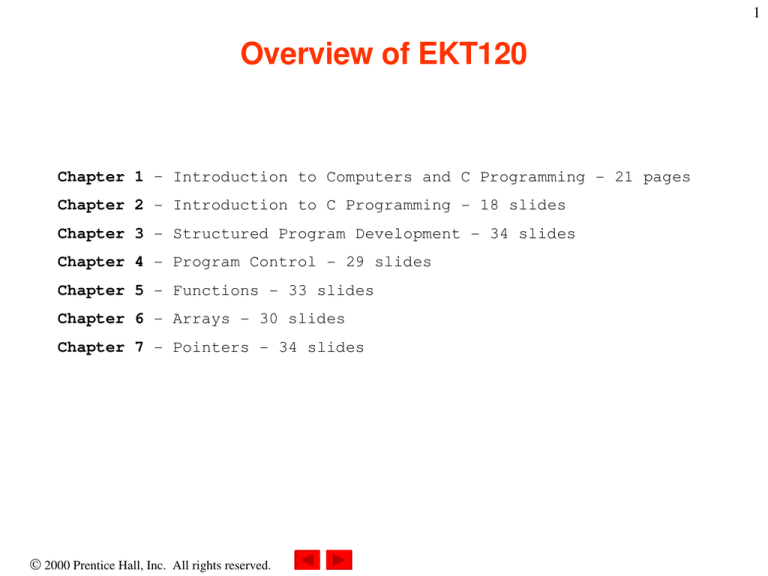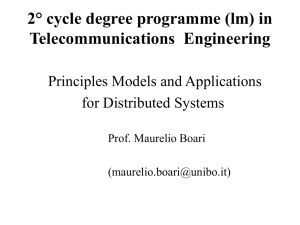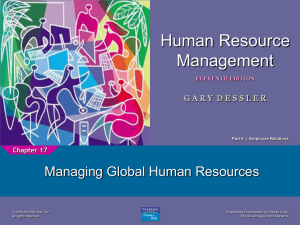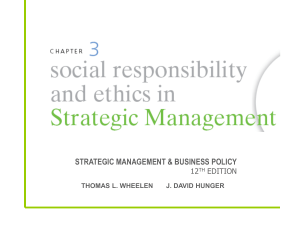
1
Overview of EKT120
Chapter 1 – Introduction to Computers and C Programming ­ 21 pages
Chapter 2 ­ Introduction to C Programming ­ 18 slides
Chapter 3 ­ Structured Program Development ­ 34 slides
Chapter 4 ­ Program Control ­ 29 slides
Chapter 5 ­ Functions ­ 33 slides
Chapter 6 ­ Arrays ­ 30 slides
Chapter 7 ­ Pointers ­ 34 slides
2000 Prentice Hall, Inc. All rights reserved.
2
Chapter 8 ­ Characters and Strings ­ 23 slides
Chapter 9 ­ Formatted Input/Output ­ 28 slides
Chapter 10 ­ Structures, Unions, Bit Manipulations, and Enumerations ­ 27 slides
Chapter 11 – File Processing ­ 39 slides
Chapter 12 – Data Structures ­ 36 slides
# Chapter 13 ­ The Preprocessor ­ 16 slides
# Chapter 14 ­ Advanced C Topics ­ 27 slides
# if time permitted.
Total Number of slides = 395 (include #), 352 (without #)
Total No. of slides perweek = 28 (include #), 25 (without #)
2000 Prentice Hall, Inc. All rights reserved.
Chapter 1 – Introduction to Computers and C Programming
Outline
1.1
1.2
1.3
1.4
1.5
Introduction
What Is a Computer?
Computer Organization
Evolution of Operating Systems
Personal Computing, Distributed Computing and Client/Server Computing
1.6
Machine Languages, Assembly Languages and High­level Languages
1.7
The History of C
1.8
The C Standard Library
1.9
The Key Software Trend: Object Technology
1.10
C++ and C++ How to Program
1.11
Java and Java How to Program
1.12
Other High­level Languages
1.13
Structured Programming
1.14
The Basics of a typical C Program Development Environment
2000 Prentice Hall, Inc. All rights reserved.
3
Chapter 1 – Introduction to Computers and C Programming
Outline
1.15
1.16
1.17
1.18
Hardware Trends
History of the Internet
History of the World Wide Web
General Notes About C 2000 Prentice Hall, Inc. All rights reserved.
4
5
1.1 Introduction
Course Outcomes
(1)Understand the concept of programming and the principals.
Memahami konsep pengaturcaraan dan prinsipnya.
(2)Ability to identify, analyse and develop computer programs using flow chart and pseudocode.
Mampu mengenalpasti, analisa dan mencipta aturcara perisian menggunakan carta alir dan kod pseudo.
(3)Familiarized with Linux environment for coding, compiling, execution and debugging
Biasa dengan persekitaran LINUX untuk pengekodan, pengkompilan, pelaksanaan dan pencarian ralat dalam aturcara komputer.
(4)Ability to think logically, creatively and innovative. Mendapatkan kemahiran pemikiran logikal, kreatif dan inovatif.
(5)Ability to work in team
Mampu bekerja dalam kumpulan
2000 Prentice Hall, Inc. All rights reserved.
6
1.2 What is a Computer?
• Computer – Device capable of performing computations and making logical decisions
– Computers process data under the control of sets of instructions called computer programs • Hardware – Various devices comprising a computer
– Keyboard, screen, mouse, disks, memory, CD­ROM, and processing units
• Software – Programs that run on a computer
2000 Prentice Hall, Inc. All rights reserved.
7
1.3 Computer Organization
•
Six logical units in every computer:
1. Input unit
•
Obtains information from input devices (keyboard, mouse)
2. Output unit •
Outputs information (to screen, to printer, to control other devices)
3. Memory unit •
Rapid access, low capacity, stores input information
4. Arithmetic and logic unit (ALU) •
Performs arithmetic calculations and logic decisions
5. Central processing unit (CPU) •
Supervises and coordinates the other sections of the computer
6. Secondary storage unit •
•
Cheap, long­term, high­capacity storage
Stores inactive programs
2000 Prentice Hall, Inc. All rights reserved.
8
1.4 Evolution of Operating Systems
• Batch processing
– Do only one job or task at a time
• Operating systems – Manage transitions between jobs
– Increased throughput
• Amount of work computers process
• Multiprogramming – Computer resources are shared by many jobs or tasks
• Timesharing
– Computer runs a small portion of one user’s job then moves on to service the next user
2000 Prentice Hall, Inc. All rights reserved.
1.5 Personal Computing, Distributed Computing, and Client/Server Computing
• Personal computers – Economical enough for individual
• Distributed computing – Computing distributed over networks
• Client/server computing
– Sharing of information across computer networks between file servers and clients (personal computers) 2000 Prentice Hall, Inc. All rights reserved.
9
•
1.6 Machine Languages, Assembly Languages, and High­level Languages
Three types of programming languages
1. Machine languages •
•
Strings of numbers giving machine specific instructions
Example:
+1300042774
+1400593419
+1200274027
2. Assembly languages
•
•
English­like abbreviations representing elementary computer operations (translated via assemblers)
Example:
LOAD BASEPAY
ADD OVERPAY
STORE GROSSPAY
2000 Prentice Hall, Inc. All rights reserved.
10
1.6 Machine Languages, Assembly Languages, and High­level Languages
1. High­level languages
•
•
•
Codes similar to everyday English
Use mathematical notations (translated via compilers)
Example:
grossPay = basePay + overTimePay
2000 Prentice Hall, Inc. All rights reserved.
11
12
1.7 History of C
• C – Evolved by Ritchie from two previous programming languages, BCPL and B
– Used to develop UNIX & Linux
– Used to write modern operating systems
– Hardware independent (portable)
– By late 1970's C had evolved to "Traditional C"
• Standardization
– Many slight variations of C existed, and were incompatible
– Committee formed to create a "unambiguous, machine­
independent" definition
– Standard created in 1989, updated in 1999
2000 Prentice Hall, Inc. All rights reserved.
13
1.8 The C Standard Library
• C programs consist of pieces/modules called functions
– A programmer can create his own functions
• Advantage: the programmer knows exactly how it works
• Disadvantage: time consuming
– Programmers will often use the C library functions
• Use these as building blocks
– Avoid re­inventing the wheel
• If a premade function exists, generally best to use it rather than write your own
• Library functions carefully written, efficient, and portable
2000 Prentice Hall, Inc. All rights reserved.
1.9 The Key Software Trend: Object Technology
• Objects – Reusable software components that model items in the real world
– Meaningful software units
• Date objects, time objects, paycheck objects, invoice objects, audio objects, video objects, file objects, record objects, etc.
• Any noun can be represented as an object
– Very reusable
– More understandable, better organized, and easier to maintain than procedural programming
– Favor modularity
2000 Prentice Hall, Inc. All rights reserved.
14
15
1.10 C++ and C++ How to Program
• C++
– Superset of C developed by Bjarne Stroustrup at Bell Labs
– "Spruces up" C, and provides object­oriented capabilities
– Object­oriented design very powerful
• 10 to 100 fold increase in productivity
– Dominant language in industry and academia
• Learning C++
– Because C++ includes C, some feel it is best to master C, then learn C++
2000 Prentice Hall, Inc. All rights reserved.
16
1.11 Java and Java How to Program
• Java is used to –
–
–
–
Create Web pages with dynamic and interactive content Develop large­scale enterprise applications
Enhance the functionality of Web servers
Provide applications for consumer devices (such as cell phones, pagers and personal digital assistants)
• Java How to Program – Closely followed the development of Java by Sun
– Teaches first­year programming students the essentials of graphics, images, animation, audio, video, database, networking, multithreading and collaborative computing 2000 Prentice Hall, Inc. All rights reserved.
17
1.12 Other High­level Languages
• Other high­level languages
– FORTRAN • Used for scientific and engineering applications
– COBOL • Used to manipulate large amounts of data
– Pascal • Intended for academic use
2000 Prentice Hall, Inc. All rights reserved.
18
1.13 Structured Programming
• Structured programming – Disciplined approach to writing programs
– Clear, easy to test and debug and easy to modify
• Multitasking
– Specifying that many activities run in parallel 2000 Prentice Hall, Inc. All rights reserved.
•
1.14 Basics of a Typical C Program Development Environment
Phases of C/C++ Programs:
●
●
●
●
●
●
Edit
Preprocess
Compile
Editor
Disk
Preprocessor
Disk
Execute Compiler
Disk
Linker
Disk
Linker links the object
code with the libraries
Primary Memory
Loader
Loader puts program in memory.
Disk
Primary Memory
CPU
2000 Prentice Hall, Inc. All rights reserved.
Program is created in
the editor and stored
on disk.
Preprocessor program
processes the code.
Compiler creates object code and stores
it on disk.
Link
Load
19
CPUtakes each
instruction and executes it, possibly storing new data values as the program executes.
20
1.15 Hardware Trends
• Every year or two the following approximately double:
– Amount of memory in which to execute programs
– Amount of secondary storage (such as disk storage)
• Used to hold programs and data over the longer term
– Processor speeds
• The speeds at which computers execute their programs
2000 Prentice Hall, Inc. All rights reserved.
21
1.16 History of the Internet
• The Internet enables
– Quick and easy communication via e­mail
– International networking of computers
• Packet switching
– The transfer of digital data via small packets
– Allows multiple users to send and receive data simultaneously
• No centralized control
– If one part of the Internet fails, other parts can still operate
• Bandwidth – Information carrying capacity of communications lines
2000 Prentice Hall, Inc. All rights reserved.
22
1.17 History of the World Wide Web
• World Wide Web – Locate and view multimedia­based documents on almost any subject
– Makes information instantly and conveniently accessible worldwide
– Possible for individuals and small businesses to get worldwide exposure
– Changing the way business is done 2000 Prentice Hall, Inc. All rights reserved.
1.18 General Notes About C
• Program clarity
– Programs that are convoluted are difficult to read, understand, and modify
• C is a portable language
– Programs can run on many different computers
– However, portability is an elusive goal
• We will do a careful walkthrough of C
– Some details and subtleties are not covered
– If you need additional technical details
• Read the C standard document
• Read the book by Kernigan and Ritchie
2000 Prentice Hall, Inc. All rights reserved.
23
24
1.1 Introduction
Course Outcomes
(1)Understand the concept of programming and the principals.
Memahami konsep pengaturcaraan dan prinsipnya.
(2)Ability to identify, analyse and develop a computer program using flow chart and pseudocode.
Mampu mengenalpasti, analisa dan mencipta aturcara perisian menggunakan carta alir dan kod Pseudo.
(3)Familiarized with Linux environment for coding, compiling, execution and debugging
Biasa dengan persekitaran LINUX untuk pengekodan, pengkompilan, pelaksanaan dan pencarian ralat dalam aturcara komputer.
(5)Ability to think logically, creatively and innovative. Mendapatkan kemahiran pemikiran logikal, kreatif dan inovatif.
(6)Ability to work in team
Mampu bekerja dalam kumpulan
2000 Prentice Hall, Inc. All rights reserved.





